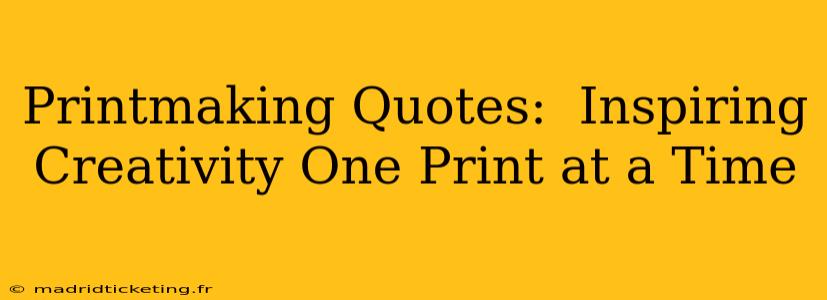Printmaking, a vibrant art form spanning centuries, continues to captivate artists and art enthusiasts alike. The process, from initial concept to the final, tangible print, is a journey of experimentation, precision, and boundless creativity. This exploration delves into the inspiring world of printmaking, punctuated by insightful quotes that resonate with the spirit of this unique medium. We'll also address some common questions surrounding printmaking and its enduring appeal.
What Makes Printmaking Unique?
Printmaking distinguishes itself from other artistic mediums through its ability to create multiple original works from a single matrix. This characteristic opens doors to exploring concepts of editioning, variations within a series, and the fascinating interplay between the artist's hand and the mechanical process. The very act of creating a print, whether it's the meticulous inking of a woodcut or the delicate layering of a silkscreen, fosters a distinct connection between the artist and their work. Many artists find the process meditative and deeply satisfying. As famed printmaker Pablo Picasso once said, "Art washes away from the soul the dust of everyday life." This sentiment perfectly encapsulates the cathartic and transformative power inherent in the printmaking process.
The Artist's Voice in Printmaking
Printmaking offers a unique platform for artistic expression. The techniques themselves – woodcut, linocut, etching, lithography, screen printing – each provide a distinct voice, influencing the final aesthetic. The marks left by the tools, the textures created, the subtle variations in ink application – all contribute to the overall narrative. This interplay between technical skill and artistic vision is precisely what makes printmaking so compelling. As renowned artist and printmaker Robert Rauschenberg stated, "Painting is self-portraiture. Printmaking is collaboration." This highlights the collaborative aspect of printmaking, engaging the artist, the medium, and sometimes even chance, to produce a unique artwork.
What are the different types of printmaking?
Printmaking encompasses a wide range of techniques, each with its own unique characteristics and challenges. Some of the most common types include:
- Relief Printing: Woodcuts and linocuts fall under this category. The image is carved into a block of wood or linoleum, leaving the raised areas to receive ink.
- Intaglio Printing: Techniques like etching and engraving involve incising lines into a metal plate. Ink settles into these grooves, creating the print.
- Lithography: This planographic process uses a flat stone or metal plate, where the image is drawn with a greasy substance that repels water. Ink adheres to the greasy areas, creating the print.
- Screen Printing (Serigraphy): This method uses a stencil on a fine mesh screen, allowing ink to pass through to create the image.
What is the difference between a print and an original artwork?
A print is considered an original work of art when it's produced by the artist themselves, directly from a matrix they have created. This differs from reproductions, which are copies of an existing artwork. Each print within an edition, though similar, exhibits unique variations due to the inherent nature of the printmaking process. This slight variation in each print adds to its character and value.
How long does it take to create a print?
The time required to create a print varies significantly depending on the chosen technique, the complexity of the design, and the artist's experience. Simple linocuts might take a few hours, while intricate etchings or multi-colored screen prints could take days or even weeks to complete.
How can I learn printmaking?
Numerous resources are available for aspiring printmakers, including workshops, classes, online tutorials, and books. Many art schools and community centers offer printmaking courses, allowing for hands-on learning and mentorship. Experimentation is key; try different techniques to discover what best suits your style and preferences. Embrace the journey, allowing the creative process to guide you. As the legendary artist M.C. Escher so aptly put it, "The only way to do great work is to love what you do." This sentiment underscores the importance of passion and dedication in any creative pursuit.
In conclusion, printmaking is a rich and rewarding artistic practice that continues to inspire and challenge artists. The inherent qualities of the medium, combined with the unique creative process, make each print a testament to the artist's skill, vision, and dedication. The quotes interwoven throughout this exploration serve as a reminder of the transformative power of art and the enduring legacy of printmaking.

